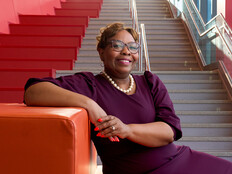Increased Role Models and Inclusive Environments Entice Women into STEM Fields
The gender gap in science, math, technology and engineering fields has been discussed a lot in recent years, and for good reason.
A recent CDW survey found that 63 percent of women who are pursuing a STEM degree have struggled with confidence in their abilities, and almost half have said that their gender has been holding them back.
When asked about the struggle, the women told CDW that the lack of female role models was the biggest issue.
Earlier this year, after discovering that female students only had a 34 percent STEM course completion, Coursera, a popular online course provider, decided to run a test.
“One hypothesis is that seeing other women in STEM could encourage female learners and help close the gap,” a Coursera blog reports.
To test this hypothesis, Coursera reports that it sent a promotional email about a machine learning course to all its learners. One email listed the course with a female instructor and the other listed a male instructor with the same credentials.
“Relative to when the instructor is obviously male, female learners were 26 percent more likely to go on and enroll in a STEM course in the following three weeks when the instructor is obviously female,” according to the blog.
Powered by this information, Coursera vowed to look for more female instructors to develop and teach STEM courses.
For women looking for more STEM role models, there are many in the field working to better it for the women who come after them.
Women in STEM Strive for Inclusivity
“The first thing [people] say to me is, ‘You don’t look like a scientist.’” Sarah Richardson, a postdoctoral fellow in biology at University of California, Berkley, told U.S. News and World Report.
“At first I thought it was funny. But, it stopped being funny when I realized my career was suffering because my colleagues also thought I didn’t look like a scientist.”
Though women make up 47 percent of the workforce, U.S. News reports that women like Richardson are still in the minority in science fields.
U.S. News also reported on a 2016 study from the University of Washington and Ohio State University, which found that the “boys’ club” culture of the tech industry was holding women back.
“While the number of women in biology, chemistry and math have increased in recent years, the gap has widened in computer science and persists in engineering and physics fields,” the article reports.
Sapna Cheryan, an associate professor at UW and a co-author of the study, tells U.S. News that she felt the sense of computer science being a masculine field even when she was in high school.
“Really what I’m trying to do is not say we need to kick the ‘Dungeons and Dragons’ boys out or make them do worse,” Cheryan says in the article. “We need to broaden the image of the field, and make it more accessible.”
UW has been already quite progressive in its push for inclusivity, thanks to the help of people like Cheryan. U.S. News reports that even in 2013, the percentage of female computer science graduates at UW was almost double the national average.









